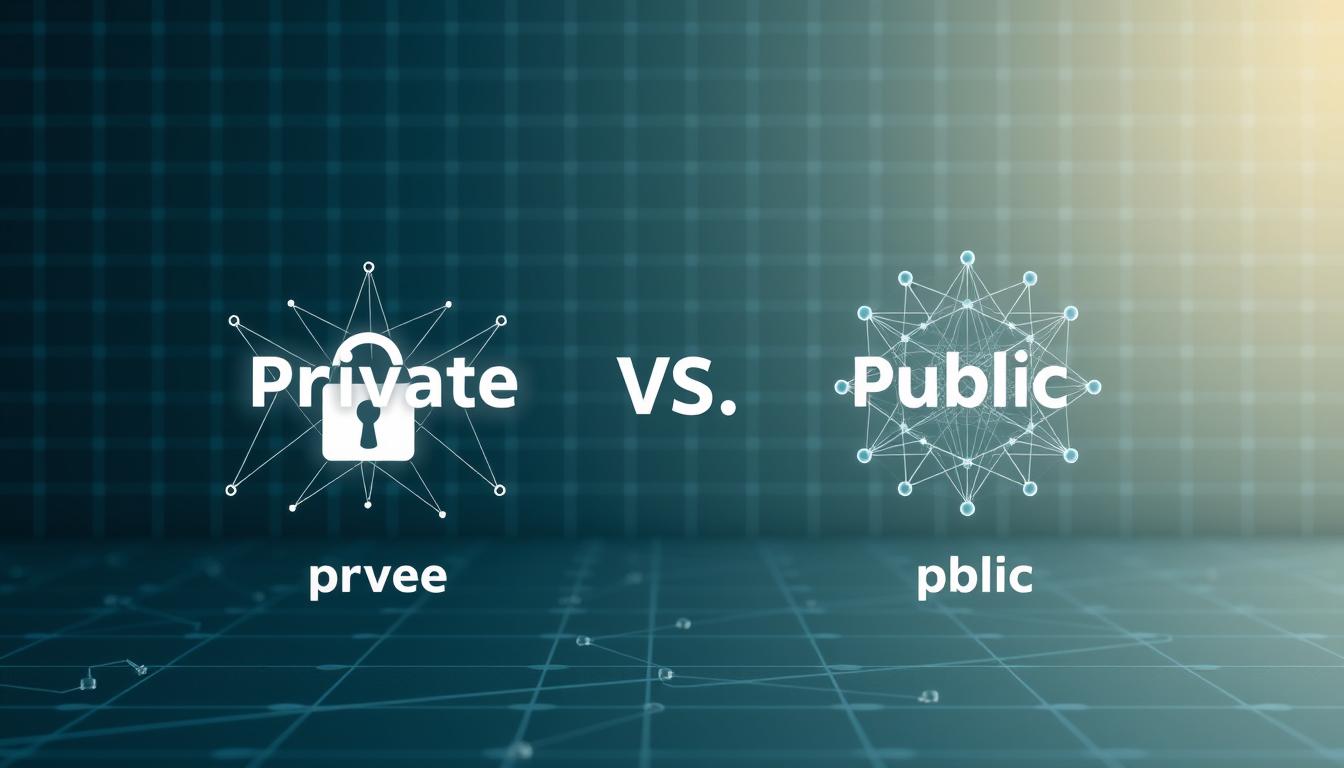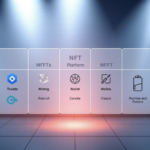Now Reading: Comparing Private and Public Blockchains: What You Need to Know
- 01
Comparing Private and Public Blockchains: What You Need to Know
Comparing Private and Public Blockchains: What You Need to Know

Blockchain technology has changed many industries by making data systems secure and transparent. When deciding between private and public blockchains, businesses need to know the differences. This guide explains how each works, their advantages and disadvantages, and their uses in the real world. It aims to help decision-makers choose the best option for their needs.
Key Takeaways
- Private and public blockchains differ in access, security, and use cases.
- Public blockchains like Bitcoin and Ethereum enable open participation.
- Private blockchains offer controlled access for enterprise needs.
- Cost and scalability vary widely between the two systems.
- Hybrid models combine features of both types for tailored solutions.
Understanding Blockchain Technology Fundamentals
Blockchain technology is key to decentralized systems. It changes how we store and share data. It uses cryptography and networks to make systems secure and open. This section explains its main parts and how it has grown over time.
The Core Components of Blockchain Architecture
Three main parts make up any blockchain:
- Blocks: These are containers for batches of transactions.
- Nodes: These are computers that check and keep copies of the ledger.
- Cryptographic hashing: This is how blocks are linked and data is kept safe.
How Distributed Ledger Technology Works
Distributed ledger technology works like this:
- Users send transactions to the network.
- Nodes check these transactions using rules (like proof-of-work).
- Good transactions are put into new blocks and added to the chain.
- Everyone updates their ledger in real time.
This way, we don’t need banks or governments in the middle.
The Evolution of Blockchain Systems
Blockchain technology has come a long way:
- 2008: Satoshi Nakamoto’s Bitcoin whitepaper started the first public blockchain.
- 2014: Ethereum brought smart contracts, making transactions programmable.
- 2020s: It’s now used in healthcare, finance, and tracking supplies.
Now, blockchain technology does more than just cryptocurrencies. It helps in supply chain and healthcare with secure systems.
Private vs Public Blockchains: Key Differences Explained
Choosing between private vs public blockchains depends on what matters most to you. Do you want openness, control, or speed? Public blockchains are open decentralized networks where anyone can join. They ensure everyone can see what’s happening but might be slower.
Private blockchains, on the other hand, only let approved people in. They offer a balance between being fast and keeping things private.

- Access Control: Public networks let anyone join, while private ones need permission.
- Decentralization: Public blockchains aim for full decentralization. Private ones give more control to a few members.
- Speed & Cost: Private blockchains are faster and cheaper because they have fewer nodes. Public ones are slower due to more nodes.
- Use Cases: Public blockchains are great for cryptocurrencies like Bitcoin. Private ones are better for industries needing to follow rules, like healthcare or finance.
Businesses face a choice: public systems offer openness but less control, while private ones are efficient but less open. Understanding these differences helps pick the right technology for your goals.
The Architecture of Public Blockchains
Public blockchains are decentralized networks where anyone can join without needing permission. They are open, allowing users to check transactions and keep the ledger themselves. This openness depends on blockchain consensus mechanisms to keep things secure and honest.
Open Access and Permissionless Participation
Anyone can join a public blockchain by downloading its software. People can mine, check transactions, or create apps without needing permission. This way, many can join in, but strong rules are needed to stop bad actions.
Public Blockchain Consensus Models
These systems use various ways to agree among nodes:
- Proof of Work (PoW): Miners solve puzzles to add blocks (e.g., Bitcoin).
- Proof of Stake (PoS): Validators are chosen based on staked coins (e.g., Ethereum 2.0).
- Delegated Proof of Stake (DPoS): Users vote for delegates to validate transactions.
These methods aim to balance speed, energy use, and security to keep the network safe.
Famous Examples of Public Blockchain Networks
Bitcoin’s PoW model is a leader in financial transactions. Ethereum added smart contracts, and Solana uses a hybrid model for fast processing. Each network is designed for different uses, like payments, NFTs, or apps.
Exploring Private Blockchain Structures
Private blockchains use permissioned blockchains to control access. They create a space where only approved members can join. This is different from public networks, where anyone can join.
These blockchains have digital gatekeepers. Companies decide who can do what, like who can see data or make transactions. This is unlike public blockchains, which are open to everyone.
Private blockchains have a central group that makes decisions. This group helps keep things running smoothly and makes sure everyone follows the rules. It’s a bit like how companies usually make decisions.
- Hyperledger Fabric: It’s designed to be flexible, used by IBM in supply chain projects.
- R3 Corda: It’s for banks, focusing on sharing data securely and legally.
- Quorum: It’s based on Ethereum, great for smart contracts and keeping data private.
These examples show how private blockchains solve big problems for companies. Banks, healthcare, and supply chains use them to keep things safe and private. They make sure everything works well together without losing the blockchain’s main benefits.
Security Considerations Across Blockchain Types
Public and private blockchain technology face different security challenges. Public blockchains are open, with nodes validating transactions. This openness makes them vulnerable to attacks like 51% control attempts.
Private blockchains, on the other hand, limit access to verified participants. This reduces external threats but increases risks from insiders or compromised credentials.
Network size and consensus models are key in blockchain security. Public systems like Bitcoin use proof-of-work, which is energy-intensive but deters attackers. Private networks use identity verification and access controls to reduce unauthorized access.
However, centralized governance in private setups can lead to single points of failure if not managed well.
Both types face common risks like phishing, smart contract flaws, and governance vulnerabilities. Organizations must focus on encryption, regular audits, and updated protocols. For example, IBM suggests using hybrid approaches with encryption and multi-party consensus to improve security.
Choosing between public or private systems depends on transparency versus control. Whether using Ethereum’s open network or Hyperledger Fabric, security strategies must address unique attack surfaces. Continuous monitoring and adaptive protocols are crucial as threats evolve.
Scalability Challenges and Solutions in Blockchain Networks
Blockchain scalability is a big challenge for the future of blockchain technology. Public blockchains like Bitcoin and Ethereum have limits in how fast they can process transactions. Private networks need to balance being fast with being secure. This section looks at how innovation tackles these problems.

Transaction Throughput Limitations
Traditional blockchains are slow because of their consensus mechanisms. Public networks can only handle about 30 transactions per second. This creates problems when there’s a lot of activity. The “blockchain scalability trilemma” means you have to choose between being fast, secure, or decentralized.
Layer 2 Solutions and Sidechains
Layer 2 solutions help by moving transactions off the main chain. Here are some examples:
- Lightning Network for Bitcoin, enabling microtransactions
- Polygon scaling Ethereum’s ecosystem
- Sidechains like RSK for Bitcoin interoperability
These methods help reduce congestion without hurting the core blockchain technology.
Scaling Strategies for Enterprise Blockchains
Private networks use permissioned access to improve performance. Companies use blockchain scalability techniques like:
- Custom consensus algorithms (e.g., Hyperledger Fabric‘s Kafka-based ordering)
- Sharding techniques dividing data into manageable segments
- Private chain pruning to remove outdated transaction data
These strategies allow for thousands of transactions per second, meeting corporate needs.
Blockchain Governance Models and Decision-Making
Blockchain governance is about how changes are made. In decentralized networks, this process is different for public and private systems. Public blockchains like Tezos use on-chain voting for updates. Polkadot also lets stakeholders decide through formal proposals.
Bitcoin, however, has off-chain governance. This means core developers and miners guide updates. This can lead to disagreements, like the Bitcoin Cash fork.
Private blockchains have rules set by central authorities. For example, Hyperledger Fabric uses committees for changes. This is different from public blockchain governance, where everyone has a say.
Private systems are faster but might lose decentralization. Public networks are more inclusive but can be slower in reaching consensus.
- Public governance: On-chain votes (Tezos, Polkadot) vs. developer-led changes (Bitcoin)
- Private governance: Pre-agreed rules within consortiums or single organizations
- Impact: Speed vs. decentralization balance affects innovation and conflict resolution
Choosing a governance model depends on what a company wants. Open blockchain governance builds trust but needs more people involved. Private systems offer control but might miss community input. Knowing these differences helps businesses pick the right governance for their needs.
Cost Analysis: Implementing and Maintaining Different Blockchain Solutions
Choosing between blockchain technology types needs careful financial planning. Companies must compare initial costs with ongoing expenses when picking between private vs public blockchains. This section outlines key cost factors to help with budgeting.

Initial development costs vary a lot. Public blockchains like Ethereum need smart contract coding and gas fee testing, costing $50k–$150k. Private networks, such as Hyperledger Fabric, require infrastructure setup, including servers and access controls, with budgets starting at $100k. Adding customization for enterprise use cases like supply chain tracking can increase costs by 30–50%.
- Public: Smart contract audits, token economics design
- Private: Server hosting, permission management tools
Ongoing costs include network maintenance. Public blockchains charge transaction fees (e.g., $30–$200 per Ethereum transaction) and need wallet management tools. Private networks have 24/7 server costs (AWS bills average $5k/month) plus annual security audits from firms like Ernst & Young. Governance platforms like Chainlink’s oracle services also add recurring fees.
ROI depends on the use case. Supply chain firms using private blockchains see 20–40% efficiency gains. DeFi platforms on public chains face 15–25% annual gas fee increases. Hidden costs like regulatory compliance (GDPR for EU-based private networks) or smart contract bug fixes often add 10–15% to total budgets.
Industry-Specific Applications of Private Blockchains
Private blockchains, or permissioned systems, are changing industries by meeting unique needs. They focus on blockchain security by controlling who can access the network. This makes them perfect for areas that need to follow rules and keep information private.
- Financial Services: Banks like JPMorgan use permissioned blockchains for blockchain security in cross-border payments. Their Interbank Information Network (IIN) cuts settlement times, reducing fraud risks through verified participant access.
- Healthcare: The MediLedger project tracks pharmaceuticals on a permissioned blockchain, ensuring drug authenticity. Hospitals share patient data securely without exposing sensitive information to unauthorized parties.
- Manufacturing: Companies like Walmart partner with IBM’s Food Trust, a private blockchain, to trace supply chains. This system improves recall accuracy and reduces audit times by 90%.
Private blockchains offer customization for sector-specific rules. For example, banks integrate regulatory reporting directly into smart contracts. In healthcare, HIPAA compliance is embedded into data-sharing protocols. These tailored solutions balance innovation with blockchain security. They show that permissioned blockchains are key for industries that value control and confidentiality.
Public Blockchain Use Cases and Success Stories
Public blockchains are changing the game in many fields. They offer clear, secure systems. This makes it easier for people all over the world to join in and access information. 
Cryptocurrency and Digital Asset Management
Bitcoin and Ethereum are key players in today’s world. Stablecoins like Tether (USDT) and USD Coin (USDC) handle over $100 billion daily. Even central banks are exploring digital currencies, like the Bahamas and Eastern Caribbean.
Platforms like Harbor let you trade real estate and art as digital assets. This opens up new markets for everyone.
Decentralized Finance (DeFi) Innovations
DeFi uses decentralized networks to make lending and trading easier. Sites like Uniswap and PancakeSwap let you swap assets instantly. Lending platforms like Aave and Compound offer loans without the need for banks.
These systems cut down on costs and barriers. They make finance available to more people, especially those who can’t access traditional banks.
Supply Chain Transparency Projects
- VeChain: Tracks pharmaceuticals and luxury goods for 600+ global brands. It has cut down counterfeit products by 40% in tests.
- Everledger: Uses Ethereum to check where diamonds come from. It stops conflict gem sales and insures $10B+ in assets every year.
These projects show how public blockchains can track products from start to finish. This builds trust in supply chains.
Hybrid Blockchain Solutions: Combining the Best of Both Worlds
Hybrid blockchain technology combines the strengths of private and public systems. It allows companies to control access while benefiting from public network security. Unlike private vs public blockchains, hybrids are flexible and meet business needs.
These designs include sidechains that connect to public ledgers or permissioned layers for internal use. For example:
- Dragonchain uses a public foundation with private execution environments
- XinFin connects enterprise networks to public Ethereum-based systems
- Ardor’s parent-child chain model separates public transparency from private processing
Logistics firms use these systems to keep sensitive data private. They verify transactions on public networks. Hybrid models solve scalability and regulatory issues. Yet, they face challenges in maintaining interoperability and consensus mechanisms.
As blockchain technology advances, hybrid solutions become more important. They offer a balance between control and decentralized security. This shows how blockchain innovation addresses real-world business challenges.
Regulatory and Compliance Factors in Blockchain Selection
Regulations play a big role in how companies use blockchain. They need to make sure their systems follow the law. This is done by using blockchain governance and permissioned blockchains to stay compliant.
Global Regulatory Landscape
- US: SEC guidelines for token sales and crypto exchanges
- EU: GDPR mandates data protection for EU citizens
- Asia: China’s crypto bans vs. Singapore’s blockchain-friendly policies
Data Privacy Considerations
The GDPR’s “right to be forgotten” is a challenge for blockchain’s immutability. To solve this, permissioned blockchains use off-chain data storage. They also use zero-knowledge proofs for privacy.
Compliance Frameworks for Enterprise
Financial firms must follow KYC/AML checks via blockchain governance protocols. Healthcare sectors use HIPAA-compliant permissioned networks. Supply chains adopt FDA and FSMA standards through auditable ledgers.
Using hybrid models is key to balancing innovation with legal rules. By focusing on regulatory alignment, companies can ensure their blockchain solutions grow and last.
Step-by-Step Guide to Choosing the Right Blockchain for Your Business
Choosing between private vs public blockchains needs a clear plan. Follow these steps to match your choice with your business goals:
- Assess core needs: List what’s most important like how fast transactions are, how private data is, and if it meets laws. Public blockchains like Ethereum are open but might not give you control. Private systems focus more on blockchain security because they limit who can access.
- Map stakeholder requirements: Get your teams involved to find out what they need. Do partners want open access (public) or do they need controlled access (private)?
- Evaluate scalability: If you handle a lot of transactions, a private network might be better. Public chains can get slow during busy times.
- Analyze compliance risks: Some industries like finance or healthcare might need private blockchains to follow data laws.
- Security protocols: Look at how both types protect data.
- Cost models: Figure out the costs for setting up and keeping both private and public options running.
- Community support: Public blockchains usually have more developers to help.
Try out your choices with a small pilot project. Start with a proof-of-concept to see if blockchain security works in real life. Get your IT team to check if it’s technically possible. Update your choice every year as technology changes. This method turns theory into practical steps for any business.
Future Trends: How Blockchain Technology Continues to Evolve
Blockchain technology is growing by linking private and public networks. This connection, through cross-chain standards, helps businesses use different systems together. It balances privacy and openness, making it useful in finance and healthcare.
Now, blockchain scalability is improving with Layer 2 solutions like sidechains. These solutions cut costs and speed up transactions. This makes it easier for big companies to use blockchain.
New blockchain consensus mechanisms include AI and quantum-resistant encryption. These updates protect networks from threats and use less energy. Hybrid models offer both efficiency and traditional decentralization.
Regulations are changing to keep up with blockchain’s growth. Central banks are looking into digital currencies, and tools help follow global rules. These steps help blockchain projects in finance and healthcare.
Businesses need to keep up with these changes to stay ahead. Focusing on interoperability, scalability, and compliance is key. Being proactive helps companies lead in this changing field.
FAQ
What is the main difference between private and public blockchains?
The main difference is in who can join. Public blockchains are open to everyone, offering full transparency and decentralization. Private blockchains, on the other hand, limit access to certain groups, focusing on efficiency and control.
How do blockchain consensus mechanisms work?
Consensus mechanisms help all nodes agree on transactions. Public blockchains use Proof of Work and Proof of Stake. Private blockchains might use faster, more traditional methods.
Are public blockchains more secure than private ones?
Yes, public blockchains are more secure due to decentralization. They’re harder to attack since a majority is needed. Private blockchains can be secure but face risks like insider threats.
What are the scalability challenges for blockchain networks?
Scalability issues come from slow transaction processing. Public blockchains struggle with decentralized validation. Private blockchains can be faster but might lose some decentralization.
How does governance differ in private and public blockchains?
Public blockchains use community governance, where anyone can participate. Private blockchains have centralized governance, controlled by a few stakeholders. This affects how fast they can change and innovate.
What should organizations consider when choosing between public and private blockchains?
Organizations should think about transaction volume, data privacy, and regulatory needs. They should also consider their specific use case and governance preferences. This helps choose the right blockchain type.
Can you explain what hybrid blockchains are?
Hybrid blockchains mix public and private blockchain features. They offer security like public networks but also efficiency and control like private ones. They’re good for organizations needing both data privacy and broad access.
How do potential regulations affect blockchain technology deployment?
Regulations are changing and vary by place. Companies must check compliance with data privacy laws and financial rules. This ensures their blockchain solutions meet legal standards.
What industries are currently utilizing private blockchains?
Finance, healthcare, and supply chain are using private blockchains. They need data privacy, compliance, and efficiency. Each field shows the benefits of private blockchains.
What is the future outlook for blockchain technology?
Blockchain’s future includes better interoperability and AI integration. There will also be more regulatory clarity and adoption of central bank digital currencies. These advancements will shape the blockchain landscape.















